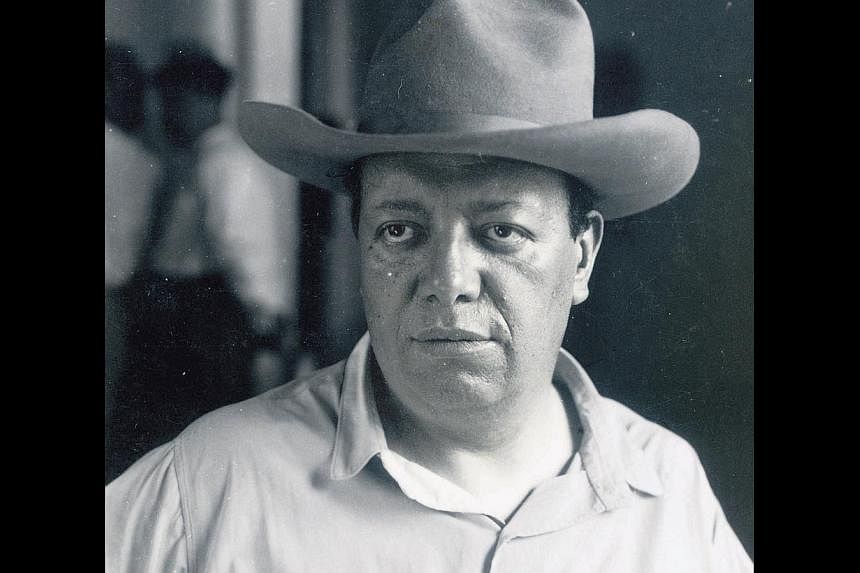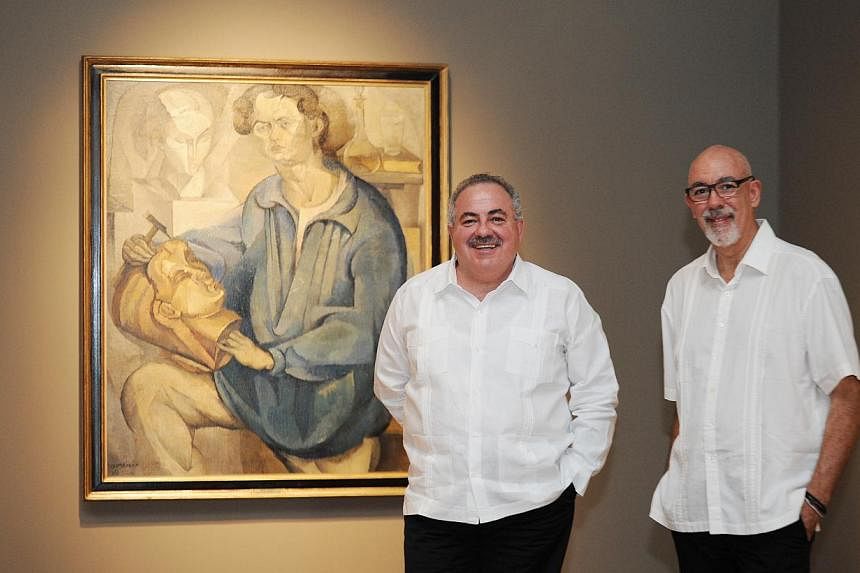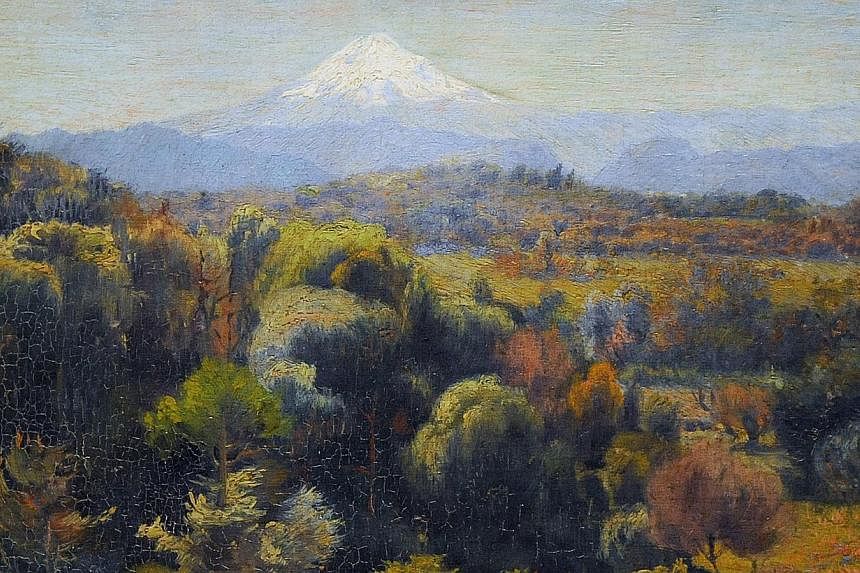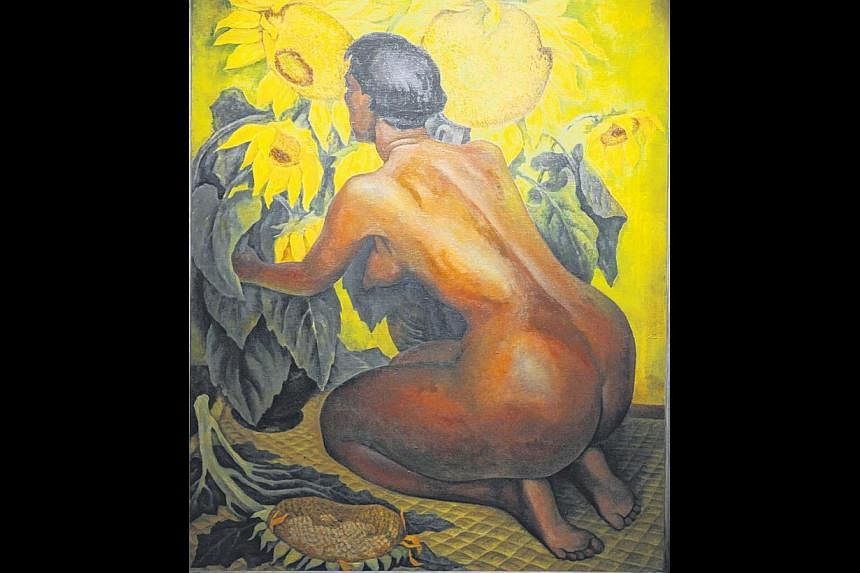In the popular imagination, the name Diego Rivera is often associated with murals depicting the working class, and the feminist icon Frida Kahlo, whom he was twice married to.
A solo exhibition of his works - the first in South-east Asia - sheds light on other facets of one of Mexico's most prolific and renowned post-revolutionary artists.
The 34 artworks on show are drawn from the collection of the state of Veracruz and rarely travel out of the country. They have, in this instance, to mark 40 years of diplomatic ties between Mexico and Singapore.
Negotiations to bring them here took nearly 11/2 years. Diego Rivera: Pride Of Mexico, an intimate but telling exhibition of many key periods of Rivera's rich artistic life, is now on at the Lim Hak Tai Gallery at the Nanyang Academy of Fine Arts. It runs till April 12.
Mr Rogelio Granguillhome, ambassador of Mexico to Singapore, calls it the "most important art exhibition of a Mexican painter in Singapore. To study our history, you have to study Diego Rivera. It reflects 50 years of Rivera's prolific career".
When asked why Mexico chose to present it at an art school instead of in a museum given the stature of the show, the diplomat said they wanted an art school setting where there is easy access to the works. He said that in Mexico, children as young as six years old are introduced to the artist's work and that the educational aspect was key in the planning of the exhibition.
Prominent Mexican journalist and art critic Santiago Espinosa de los Monteros is in town to talk about the artist's life and the various influences that shaped it and also to present lectures on contemporary Mexican art for the faculty and students.
He told Life!: "Diego is many Diegos. He was not only an artist, but also an activist. He had a turbulent personal life which is well documented. He had many contradictions and we are here trying to explain what his art is all about, not to judge him."
The Veracruz collection grew "organically" when Rivera's patron, state governorTeodoro A. Dehesa Mendez, gave the artist a grant to travel to Europe in 1906. It was his first trip to the continent.
Even though he was not expected to, Rivera often sent his works to Dehesa out of gratitude for the support his benefactor gave him. Two subsequent governors continued to add works to the collection, making it one of the most important public collections on Rivera.
"These works demonstrate there is much more to Rivera's life than the celebrated murals he created. He painted high society. He excelled in portraiture and in landscapes. Above all, his art was rooted in his country. He had a unique empathy for our people," said Espinosa, 58.
Even in his small drawings and paintings, such as the 1935 charcoal drawing and watercolour Child With Chicken, there is what Espinosa called "his economy of media, his expressive ways of using the line and how his art evolved as he journeyed".
The Mexican master's career spanned more than 50 years. After the Mexican Revolution against dictator Jose de la Cruz Porfirio Diaz Mori ended in 1921, Rivera, an architect by training and a muralist, was commissioned to celebrate the glories and triumphs of the struggle on canvas.
The show in Singapore does not include his famous giant murals, except two reproductions, but there are some very early drawings of his artistic career, an early portrait of his mother, works on high society, some arresting renditions of nudes and works he did up to a year before his death in 1957.
Highlighting works such as the 1915 Still Life With Glass And Bottle,Espinosa said: "You cannot divorce Mexican art history and the history of art in Europe and North America. There were many influences."
Rivera went to Europe twice and lived there from 1911 to 1921. This was when he was significantly influenced by ideas of the revolution in Russia and learnt about Cubism from masters including Picasso and Modigliani. He would find his own style within Cubism while experimenting with geometry and colour and injecting elements of Mexican life into his works.
This is best seen in his celebrated 1946 painting Nude With Sunflowers, which brings to life the colours of the country on canvas. His portraits stand out not only for the attention to detail, but also for his ability to portray an emotion while presenting various facial angles. A particularly telling one is a 1904 portrait of his mother, Portrait Of The Painter's Mother. It captures all the fine lines on her face, making the viewer think of the life she led. Though Rivera's personal life was exceptionally turbulent - he had four wives and several affairs - he managed not to let that distract from his art.
In an e-mail response, Ms Magdalena Zavala Bonachea, the national coordinator of visual arts at Mexico's National Institute of Fine Arts, who is also the curator of the show, called him "a man who was unusual for his time. He was at the centre of many controversies, yet he remained till the very end a staunch defender of artistic expression and a champion of individual rights".
The one aspect of Rivera's life that stands out for Espinosa was "his extreme generosity". "He gifted his home and all that was in it. It is now the Diego Rivera Museum, Guanajuato. He left a legacy for the future and, through his art, a look at how our country's history was shaped."
HIGHLIGHTS OF DIEGO RIVERA EXHIBITION
Exhibition curator Magdalena Zavala Bonachea, who is also the national coordinator of visual arts at the National Institute of Fine Arts in Mexico, picks three highlights from the show:
1. NUDE WITH SUNFLOWERS, 1946

As an artist, Diego Rivera tried his best to understand and portray Mexico's spirit to the world. The country itself is full of complex and paradoxical images which influenced his art greatly. This iconic painting is a reflection of many of those influences. Ms Bonachea, 51, says: "You can see Diego's roots, a mix of colours and landscapes that you can find in Mexico. This is his most distinctive style that portrays Mexican society."
2. PAISAJE DE TOLEDO, 1913

The Landscape Of Toledo is widely regarded as one of the pieces that marked a turning point in Rivera's art practice. It was heavily influenced by the artist's visit to Europe, where he discovered and studied avant-garde art forms including Cubism, elements of which are seen in the works he would create later.
The work shows how the artist's subject, palette as well as brush strokes changed significantly as he travelled and interacted with artists in Europe. Compared with his 1906 landscape, the pieces he did during this period became a little more abstract.
3. PICO DE ORIZABA, 1906

Pico de Orizaba Mountain is one of the first landscapes that Rivera painted in the formative stages of his career. This piece captivated state governor Teodoro A. Dehesa Mendez in his home state of Veracruz. The art lover was the one who supported Rivera's studies and his trip to Europe. The curator points out that "this painting is one of the pieces that started the Veracruz collection".
DIEGO RIVERA'S LIFE
- 1886: Born in Guanajuato, Mexico
- 1896: At the age of 10, went to study art at the San Carlos Academy of Fine Arts in Mexico City. Among his early influences was illustrator Jose Posada, whose printmaking workshop he often visited.
- 1907: His early work captivated the Governor of Veracruz, his home state. Art lover Teodoro A. Dehesa Mendez supported Rivera's trip to Europe, where he worked in the studio of the leading Spanish realist Eduardo Chicharro y Aguera and became friends with several leading artists of his time, including Spanish master Pablo Picasso.
- 1911-1921: Regarded as the Rivera in France period. He spent time in several cities, including Paris, befriended many artists and studied the European art movements of the time.
- 1921: Returned to Mexico.
- 1923: Completed the first of the murals at the Escuela Nacional Preparatoria, the oldest public high school in Mexico City. This was funded by the Mexican government.
- 1929: Married Frida Kahlo, who was then an aspiring artist.
- 1930s: Painted several murals in the United States.
- 1934: Millionaire art patron Nelson Rockefeller ordered the demolition of Rivera's controversial mural Man At The Crossroads at Rockefeller Center in New York City, causing strong public backlash. The mural portrayed Russian communist leader Vladimir Lenin and was considered anti-capitalist propaganda.
- 1939: Divorced Kahlo.
- 1940: The couple reunited and remarried.
- 1940: Presented 10 murals at the Golden Gate International Exposition held in San Francisco.
- 1957: Rivera died of heart failure, three years after the death of Kahlo in 1954.





